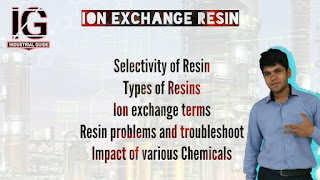Ion exchange resin | Essential knowledge of DM Plant
Hello Readers
In this blog we will cover following topics1. Introduction
2. Selectivity of Resin
3. Types of Resins
4. Ion exchange terms
5. Resin problems and troubleshoot
6. Impact of various Chemicals
[ads id="ads1"]
1. Introduction of Ion exchange resins
Water containing dissolved salts ( Electrolyte, ions) of Na+, Ca+2, Mg+2 SO4-2 Cl- Silica etc. This impurities makes problems in heating or cooling system of Scaling , chocking etc.Ion exchange resins made to remove this impurities. It is available for household use to Industrial uses.
2. Selectivity of Resin
Selectivity of resin is depending upon ions present in solution being replaced. Ex: Ca+2, Mg+2 are replaced by Cation resins, SO4-2 OH- , Cl- ions are removed by Anion resins. Rest of the ions are replaced by Mixed bed resins contains both Cation and Anion specialty grade.[ads id="ads1"]
3. Types of Resins
A. Strong acid cation resins B. Weak acid cation resins
A. Strong acid cation resinsC. Strong base anion resins D. Weak base Anion resin
- Strong acid cation contains SO3H+ group.
- These resins working on entire pH scale.
- It can be use in all softening applications even in two bed DM plants.
- Made from Styrene & Divinayl benzene
- Weak acid cation resins containing -COOH group as exchange site.
- It regenerate perfectly as theoretically acid requirement but Strong acid cation resin requires 200 - 300% acid.
- It is made from methacrylic acid
- It gives best efficiency at 1. Low flow rates 2. Low temperature
- This resins derive their function group from Ammonium exchanging sites with two extensions.
- Type 1 has methyl groups, Type 2 has ethanol replaces one of the methyl groups.
- Type 1 resin are used for total anion removal on all waters.
- Type 2 resin are used on high temperature, High alkinity and high silica. It is less effective than type one for all anion removal.
- Resin containing Polyamine functional group which adsorbing free mineral acidity
- This resin regenerated with calculated Caustic NaOH amount
- Usable in high amount of chloride and sulphate in raw water this resin is not much affect on Si & Alkinity.
[ads id="ads1"]
4. Ion exchange terms
TEC - Total Exchange Capacity.
This term is refer the portion of TEC of resin volume
Colorthrow - After some time passing resin changing its color due to its structure broken by oxidants. It indicates service life of an resin.
Fines - When resin manufactured it also produce smaller particles. When it is high in resin it not pass liquid flow. It also increase Pressure drop across Ion exchange column.
[ads id="ads1"]
5. Resin problems and troubleshoot
Raw water supply -Raw water supply parameters must maintain for long resin active life
Maximum temperature allowable limit -
Cation resin - 120°C Anion strong base - 48°C
Anion Weak base - 38°C
Free Chlorine 0.5 ppm
Turbidity - 5 ppm
Iron - dissolved form
Manganese - Dissolved form
Hydrogen sulfide - 0.5 ppm
Oil - Nil
Resin is a chemical structure which exchange from water with active exchange sites. If contaminated water is used resin may be harm with permanent ions. this contamination makes ion exchange resin non regenerative.
Colloidal matter coats surface of ion exchange resin particles. There are some pre treatments available which installed to run DM Plant longer time.
Free Chlorine 0.5 ppm
Turbidity - 5 ppm
Iron - dissolved form
Manganese - Dissolved form
Hydrogen sulfide - 0.5 ppm
Oil - Nil
Resin is a chemical structure which exchange from water with active exchange sites. If contaminated water is used resin may be harm with permanent ions. this contamination makes ion exchange resin non regenerative.
Colloidal matter coats surface of ion exchange resin particles. There are some pre treatments available which installed to run DM Plant longer time.
- Floculation / Coagulation system
- Clarifying system
- Sand Filters
- MGF [ mix grade filters]
- ACF [ Activated carbon filters ]
- Bag filters
- Candle filters
- RO [ Reverse osmosis membrane ]
There is a specialty resins for each type of contamination and filtration purpose. More than 70 types of resins are available for various ion exchange treatments.
High raw water flow -
Raw water flow must be fixed as per resin quantity. If higher flow rates are there is possibility of early exhaust of resin. Exhausted resin required regeneration. Regeneration process is regular basic process.
Idle time -
When DM plant is not in use for 7 days or more Resins must be in wet condition with brine. Dry condition for resin is dangerous. If shutdown is lesser than 7 days resin must be wet with water.
When plant startup going on Brine or Water must be washed with fresh pure water.
[ads id="ads1"]
High raw water flow -
Raw water flow must be fixed as per resin quantity. If higher flow rates are there is possibility of early exhaust of resin. Exhausted resin required regeneration. Regeneration process is regular basic process.
Idle time -
When DM plant is not in use for 7 days or more Resins must be in wet condition with brine. Dry condition for resin is dangerous. If shutdown is lesser than 7 days resin must be wet with water.
When plant startup going on Brine or Water must be washed with fresh pure water.
[ads id="ads1"]
6. Impact of various Chemicals
Resins are highly affected by these chemicals- Aluminium hydroxide
- Oil
- Calcium sulfate
- Silica
- Magnesium hydroxide
- Chlorine
- Organic matter
Read more about "Utility Blogs" from Industrial Guide - Click here
Important linksWikipedia - https://en.wikipedia.org/wiki/Ion-exchange_resin
Ion exchange limited - Visit website
Lanxess limited - Visit website
Thermax Limited - Visit website
Toyoto Limited - Visit website
Photo credits

